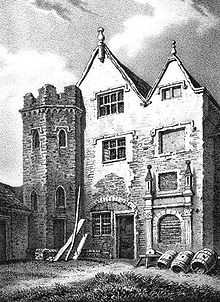Francis Gawdy

"having this manor, in right of his wife, he induced her to acknowledge a fine thereof upon which she became a distracted woman and continued so to the day of her death and was to him for many years a perpetual affliction"

Perhaps because she believed (correctly) he had cheated her out of interest from Eston Hall, her ancestral home.[2] He also obtained Fincham Hall[1] and Wallington Hall which had been in the possession of Elizabeth's father, William Coningsby's family.[4] Collinsby had been the recorder in King's Lynn[5]
Gawdy succeeded his elder brother, the middle Thomas Gawdy, as a justice of the King's Bench in 1588, and took part in many of the major trials of this period, including that of Sir Walter Raleigh in 1603, and was knighted the same year. Gawdy apparently expected to succeed Sir William Peryam as Lord Chief Baron of the Exchequer, but James I informed him he was being saved for a more senior position when it became available, appointing Sir Thomas Fleming instead. In August 1605 Gawdy was appointed Chief Justice of the Common Pleas, a position he did not get to enjoy, dying of apoplexy on 15 December at Serjeant's Inn.[2] He had one daughter who was also called Elizabeth.[4]
After his death his body was brought from London to Wallington and it is said that they could find no place to bury his body as he was refused space locally.[5] (Gawdy had depopulated the town around his hall and converted the church to a dog kennel or hay store.) As the smell of the body became offensive he was eventually buried without ceremony at Runcton church and only paving stones were used to cover the grave. The parish register at Runcton records that he was buried in the chancel by the local parson on 27 February (although the differing calendars would account for much of this apparent delay).[1]
It was noted in 1829 that Wallington church was in ruins although the Hall was well repaired.[4] Wallington Hall which has been described as a "Tudor Rose in Bloom". The house still stands today in nearly 600 acres (2.4 km2) near Kings Lynn and was valued at five million pounds in 2006.[5]
References
- ↑ 1.0 1.1 1.2 Runcton registers cited in Historical Notices and Records of the Village and Parish of Fincham, William Blyth, p16, 1863, accessed 24 September 2008
- ↑ 2.0 2.1 2.2 2.3 Oxford DNB:Gawdy, Sir Francis
- ↑ Though the ODNB suggests this possibility, Venn's Alumni Cantabrigienses identifies the Thomas Gawdy in question as Francis's older half-brother Thomas (died 1588)
- ↑ 4.0 4.1 4.2 A General History of the County of Norfolk Intended to Convey All the Information of a Norfolk Tour, with the More Extended Details of Antiquarian, Statistical, Pictorial, Architectural, and Miscellaneous Information; Including Biographical Notices, Original and Selected, edited by John Chambers, 1829, accessed 24 September 2008
- ↑ 5.0 5.1 5.2 A Tudor Rose in Bloom, The Times Online, 16 June 2006 accessed 24 September 2008
| Legal offices | ||
|---|---|---|
| Preceded by Sir Edmund Anderson |
Chief Justice of the Common Pleas 1605 |
Succeeded by Sir Edward Coke |
| Parliament of England | ||
| Preceded by Unknown |
Member of Parliament for Morpeth 1571 |
Succeeded by Unknown |
|